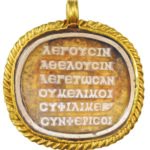Talking Ancient Cameos: What Ancient Greek Sounded Like
Nunc est bibendum is a non-profit cultural association dedicated to the evocation of antiquity through the arts of the table.
A Viral Love Poem in the Ancient World
Association NUNC
https://nunc.ch/en/a-viral-love-poem-in-the-ancient-world/
“From present-day Spain to Mesopotamia, the same Greek words can be found, generally engraved on inexpensive precious stones (agate, onyx or sardonyx). The best-preserved examples were found on a piece of jewellery around the neck of a young woman in a sarcophagus in Hungary and inscribed on a wall in ancient Cartagena.

in present-day Hungary. Photo: Péter Komjáthy/BHM Aquincum Museum and Archaeological Park
Professor Tim Whitmarsh of Cambridge University is convinced that by linking these different artefacts, he has put his finger on the expression of ancient “pop culture”. The equivalent of a rock song, a theme that could have been written by the Sex Pistols,” he ventured, interviewed in September 2021 by The Guardian newspaper. Indeed, the tone of the millennial poem resonates with the “And we don’t care” of the British punk band’s Pretty Vacant:
Λέγουσιν – They say
ἃ θέλουσιν – what they want
λεγέτωσαν – let them talk
οὐ μέλι μοι – I don’t care
σὺ φίλι με – come on, love me!
συνφέρι σοι – it does you good
The Cambridge professor believes that this poem was disseminated on a large scale, orally of course, from tavern to tavern, but also mass-produced on objects such as the semi-precious stones found and sold throughout the Roman Empire[1]. It would have served as a distinctive sign for a middle class eager to mark its difference and extricate itself from the local culture: while the love theme of the poem and its poetic form are very simple, the use of Greek was “classy”.
But that’s not all. The researcher also noted that the poem was distinguished by the form of metre used. This is a far cry from the scansion used by classics such as Homer, with a rhythm based on syllables of different durations. For these verses of four syllables each, the musicality is based on accentuation: a strong accent on the first syllable and a weaker one on the third. Until now, it was thought that this form of accented verse had only begun to be used in Byzantine Christian hymns in the 5th century.
“You didn’t need specialist poets to create this kind of musicalised language, and the diction was very simple, so it was clearly a democratic form of literature,” says Tim Whitmarsh. It reveals another culture, buried beneath the classical culture of the elites that has reached us best, that of a people who look like us.
From the Greek Reporter
What Ancient Greek Sounded Like?
“Reading like the lyrics to a popular song or poem from modern times, two ancient Greek inscriptions in the form of rhyming poetry have prompted new insights into the way the language was spoken in those times.”
Tap here for more from the Greek Reporter!

(GLASS) medallion found in a sarcophagus in present-day Hungary.
The ancient Greek love poem shows how the spoken language actually sounded, according to new research.
Credit: Peter Komjathy/BHMAquincum Archaeological Museum and Park
The Aquincum Museum’s Archaeological Park, one of the largest Roman archaeological parks in Hungary, has a history of over 110 years.
It displays the remains of around a quarter of the Aquincum Civil Town including the most characteristic public buildings
and several private houses, reflecting the town’s layout during the 2nd and 3rd centuries AD.
From the Cambridge University Press: a much more academic review
LESS CARE, MORE STRESS: A RHYTHMIC POEM FROM THE ROMAN EMPIRE













